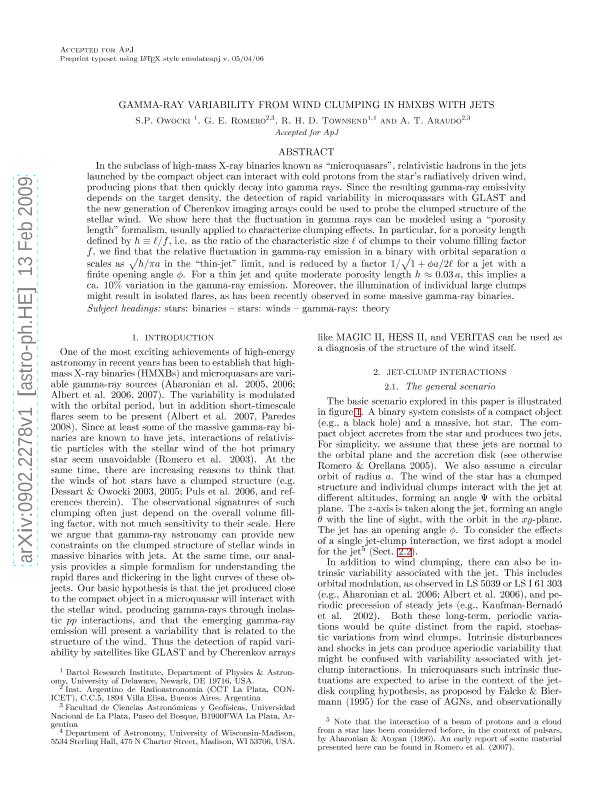Artículo
Gamma-Ray Variability from Wind Clumping in High-Mass X-Ray Binaries with Jets
Fecha de publicación:
05/2009
Editorial:
IOP Publishing
Revista:
Astrophysical Journal
ISSN:
0004-637X
Idioma:
Inglés
Tipo de recurso:
Artículo publicado
Clasificación temática:
Resumen
In the subclass of high-mass X-ray binaries known as “microquasars”, relativistic hadrons in the jets launched by the compact object can interact with cold protons from the star’s radiatively driven wind, producing pions that then quickly decay into gamma rays. Since the resulting gamma-ray emissivity depends on the target density, the detection of rapid variability in microquasars with GLAST and the new generation of Cherenkov imaging arrays could be used to probe the clumped structure of the stellar wind. We show here that the fluctuation in gamma rays can be modeled using a “porosity length” formalism, usually applied to characterize clumping effects. In particular, for a porosity length defined by h ≡ ℓ/f, i.e. as the ratio of the characteristic size ℓ of clumps to their volume filling factor f, we find that the relative fluctuation in gamma-ray emission in a binary with orbital separation a scales as p h/πa in the “thin-jet” limit, and is reduced by a factor 1/ p 1 + φa/2ℓ for a jet with a finite opening angle φ. For a thin jet and quite moderate porosity length h ≈ 0.03 a, this implies a ca. 10% variation in the gamma-ray emission. Moreover, the illumination of individual large clumps might result in isolated flares, as has been recently observed in some massive gamma-ray binaries.
Palabras clave:
Binary Stars
,
Star Winds
,
Gamma Rays
,
Microquasars
Archivos asociados
Licencia
Identificadores
Colecciones
Articulos(IAR)
Articulos de INST.ARG.DE RADIOASTRONOMIA (I)
Articulos de INST.ARG.DE RADIOASTRONOMIA (I)
Citación
Owocki, S. P.; Romero, Gustavo Esteban; Townsend, R. H. D.; Araudo, Anabella Teresa; Gamma-Ray Variability from Wind Clumping in High-Mass X-Ray Binaries with Jets; IOP Publishing; Astrophysical Journal; 696; 1; 5-2009; 690-693
Compartir
Altmétricas




